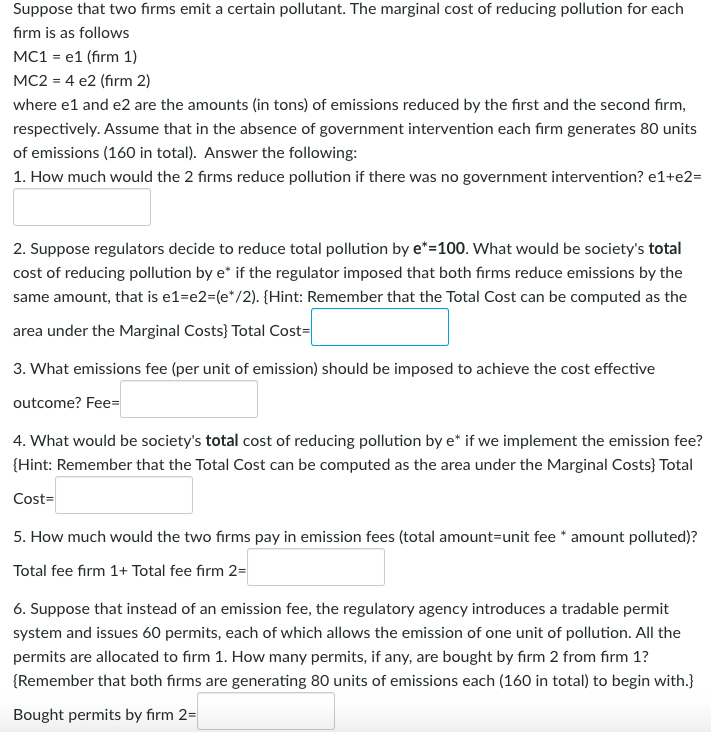Suppose that two firms emit a certain pollutant. The marginal cost of reducing pollution for each firm is as follows MC1 = e1 (firm 1) MC2 = 4 e2 (firm 2) where el and e2 are the amounts (in tons) of emissions reduced by the first and the second firm, respectively. Assume that in the absence of government intervention each firm generates 80 units of emissions (160 in total). Answer the following: 1. How much would the 2 firms reduce pollution if there was no government intervention? e1+e2 2. Suppose regulators decide to reduce total pollution by e*=100. What would be society's total cost of reducing pollution by e* if the regulator imposed that both firms reduce emissions by the same amount, that is e1=e2=(e*/2). {Hint: Remember that the Total Cost can be computed as the
Suppose that two firms emit a certain pollutant. The marginal cost of reducing pollution for each firm is as follows MC1 = e1 (firm 1) MC2 = 4 e2 (firm 2) where el and e2 are the amounts (in tons) of emissions reduced by the first and the second firm, respectively. Assume that in the absence of government intervention each firm generates 80 units of emissions (160 in total). Answer the following: 1. How much would the 2 firms reduce pollution if there was no government intervention? e1+e2 2. Suppose regulators decide to reduce total pollution by e*=100. What would be society's total cost of reducing pollution by e* if the regulator imposed that both firms reduce emissions by the same amount, that is e1=e2=(e*/2). {Hint: Remember that the Total Cost can be computed as the
Advanced Engineering Mathematics
10th Edition
ISBN:9780470458365
Author:Erwin Kreyszig
Publisher:Erwin Kreyszig
Chapter2: Second-order Linear Odes
Section: Chapter Questions
Problem 1RQ
Related questions
Question

Transcribed Image Text:Suppose that two firms emit a certain pollutant. The marginal cost of reducing pollution for each
firm is as follows
MC1 = e1 (firm 1)
MC2 = 4 e2 (firm 2)
where e1 and e2 are the amounts (in tons) of emissions reduced by the first and the second firm,
respectively. Assume that in the absence of government intervention each firm generates 80 units
of emissions (160 in total). Answer the following:
1. How much would the 2 fırms reduce pollution if there was no government intervention? e1+e2=
2. Suppose regulators decide to reduce total pollution by e*=100. What would be society's total
cost of reducing pollution by e* if the regulator imposed that both firms reduce emissions by the
same amount, that is e1=e2=(e*/2). {Hint: Remember that the Total Cost can be computed as the
area under the Marginal Costs} Total Cost=
3. What emissions fee (per unit of emission) should be imposed to achieve the cost effective
outcome? Fee=
4. What would be society's total cost of reducing pollution by e* if we implement the emission fee?
{Hint: Remember that the Total Cost can be computed as the area under the Marginal Costs} Total
Cost=
5. How much would the two firms pay in emission fees (total amount=unit fee * amount polluted)?
Total fee firm 1+ Total fee firm 2=
6. Suppose that instead of an emission fee, the regulatory agency introduces a tradable permit
system and issues 60 permits, each of which allows the emission of one unit of pollution. All the
permits are allocated to firm 1. How many permits, if any, are bought by fırm 2 from firm 1?
{Remember that both firms are generating 80 units of emissions each (160 in total) to begin with.}
Bought permits by firm 2=

Transcribed Image Text:7. Is it true that in this setting Cap-and-Trade is more efficient than Emission Fee? {U=Uncertain}
(Y/N/U)
8. If the government was undecided between the Emission Fee versus the Cap-and-Trade system, is
it true that firm 2 would lobby to implement Cap-and-Trade? {Hint: think carefully. U=Uncertain}
(Y/N/U)
Expert Solution
This question has been solved!
Explore an expertly crafted, step-by-step solution for a thorough understanding of key concepts.
This is a popular solution!
Trending now
This is a popular solution!
Step by step
Solved in 4 steps with 3 images

Recommended textbooks for you

Advanced Engineering Mathematics
Advanced Math
ISBN:
9780470458365
Author:
Erwin Kreyszig
Publisher:
Wiley, John & Sons, Incorporated

Numerical Methods for Engineers
Advanced Math
ISBN:
9780073397924
Author:
Steven C. Chapra Dr., Raymond P. Canale
Publisher:
McGraw-Hill Education

Introductory Mathematics for Engineering Applicat…
Advanced Math
ISBN:
9781118141809
Author:
Nathan Klingbeil
Publisher:
WILEY

Advanced Engineering Mathematics
Advanced Math
ISBN:
9780470458365
Author:
Erwin Kreyszig
Publisher:
Wiley, John & Sons, Incorporated

Numerical Methods for Engineers
Advanced Math
ISBN:
9780073397924
Author:
Steven C. Chapra Dr., Raymond P. Canale
Publisher:
McGraw-Hill Education

Introductory Mathematics for Engineering Applicat…
Advanced Math
ISBN:
9781118141809
Author:
Nathan Klingbeil
Publisher:
WILEY

Mathematics For Machine Technology
Advanced Math
ISBN:
9781337798310
Author:
Peterson, John.
Publisher:
Cengage Learning,

